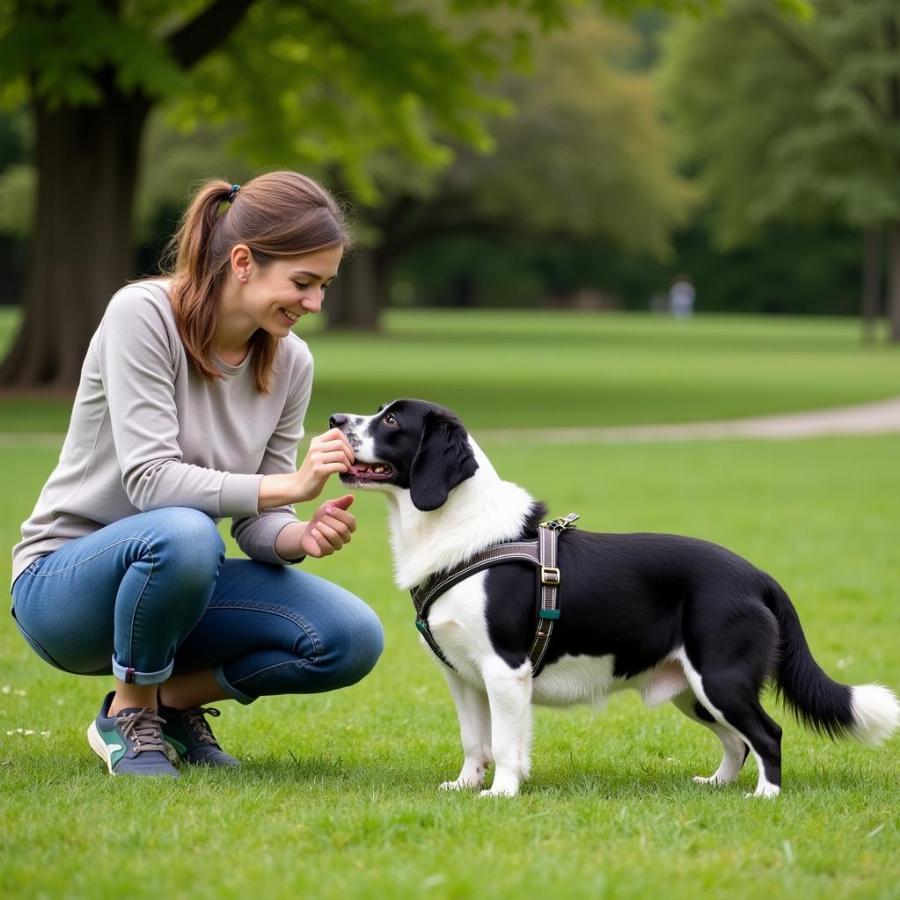Negative reinforcement dog training is often misunderstood. Many people confuse it with punishment, but it’s actually a gentle and effective way to teach your furry friend desired behaviors. In this comprehensive guide, we’ll delve deep into the world of negative reinforcement, exploring its principles, benefits, and how to implement it correctly to build a strong bond with your canine companion.
What is Negative Reinforcement Dog Training?
Negative reinforcement is all about removing something unpleasant to strengthen a desired behavior. It’s important to remember that “negative” in this context doesn’t mean “bad.” It simply refers to taking something away.
Think of it this way: imagine your dog pulling on the leash during a walk. Instead of yanking the leash or scolding, you stop moving. The unpleasant tension on the leash is removed when your dog stops pulling. Over time, your dog learns that not pulling leads to a more enjoyable walk.
Positive Reinforcement vs. Negative Reinforcement
Many people confuse negative reinforcement with positive punishment, but they are distinct concepts:
- Positive Reinforcement: Adding something pleasant to increase a behavior (e.g., giving a treat when your dog sits).
- Negative Reinforcement: Removing something unpleasant to increase a behavior (e.g., loosening leash pressure when your dog walks calmly).
- Positive Punishment: Adding something unpleasant to decrease a behavior (e.g., yelling “No!” when your dog jumps on someone).
- Negative Punishment: Removing something pleasant to decrease a behavior (e.g., ignoring your dog when they demand attention by pawing).
Benefits of Negative Reinforcement in Dog Training
Negative reinforcement, when used correctly, can be incredibly effective and humane:
- Stress-Free Learning: It avoids the use of force or intimidation, creating a more positive learning environment for your dog.
- Clear Communication: By focusing on removing unpleasant stimuli, you help your dog understand what you want without confusion.
- Improved Bond: Building trust is essential, and negative reinforcement helps strengthen your relationship by focusing on cooperation.
- Versatility: It can be applied to various training scenarios, from basic obedience to addressing behavioral issues.
How to Use Negative Reinforcement Effectively
Here are some practical tips for using negative reinforcement in dog training:
- Identify the Aversive: Determine what your dog finds unpleasant and wants to avoid (e.g., leash pressure, a high-pitched sound).
- Timing is Key: The aversive should be removed the instant your dog performs the desired behavior.
- Be Consistent: Use the same cues and timing every time to avoid confusion.
- Start Gradually: Begin with small steps and gradually increase the difficulty as your dog progresses.
- Combine with Positive Reinforcement: Using both methods can lead to faster and more effective learning.
Examples of Negative Reinforcement in Dog Training
Here are some examples of how you can incorporate negative reinforcement into your training:
- Loose Leash Walking: As mentioned earlier, stopping when your dog pulls and resuming when the leash slackens teaches them to walk calmly.
- Recall Training: If your dog hesitates to come when called, gently reel them in with a long line until they reach you, then release the tension.
- Crate Training: If your dog whines in their crate, avoid letting them out immediately. Wait for a pause in the whining, then open the door, reinforcing quiet behavior.
 Dog Training With Owner Outdoors
Dog Training With Owner Outdoors
Common Mistakes to Avoid
- Confusing with Punishment: Remember, negative reinforcement is about removing something unpleasant, not adding something aversive.
- Inconsistent Timing: Delaying the release of pressure or removal of the aversive will confuse your dog.
- Using Harsh Aversives: Avoid anything that causes pain or fear, as this can damage your bond and lead to behavioral problems.
When to Seek Professional Help
While negative reinforcement can be effective, it’s essential to consult a certified professional dog trainer if you encounter challenges or your dog displays signs of fear or aggression. A trainer can assess your situation and provide tailored guidance.
Negative Reinforcement: A Humane and Effective Training Approach
Negative reinforcement, when understood and applied correctly, is a valuable tool for shaping desired behaviors in dogs. By focusing on removing unpleasant stimuli, you can create a positive learning experience that strengthens your bond and fosters a well-behaved companion.
FAQs About Negative Reinforcement Dog Training
Q: Is negative reinforcement harmful to my dog?
A: No, when used correctly, negative reinforcement is not harmful. It avoids physical corrections and focuses on removing unpleasant sensations, making it a humane training method.
Q: Can I use negative reinforcement with a puppy?
A: Yes, but it’s crucial to be extra gentle and patient with puppies. Their attention spans are shorter, and they are still learning about the world.
Q: What if my dog doesn’t respond to negative reinforcement?
A: There could be various reasons, such as the aversive not being strong enough or an underlying behavioral issue. Consult a certified dog trainer for guidance.
Looking for More Dog Training Tips?
Check out these related articles:
About Beaut Dogs
Beaut Dogs is your one-stop resource for all things dog-related. We provide expert advice, tips, and insights to help you navigate the wonderful world of dog ownership. For personalized support, contact us at [email protected].